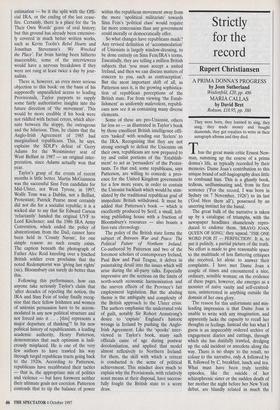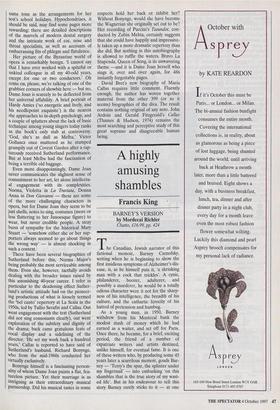Strictly • for the record
Rupert Christiansen
They were born, they learned to sing, they sang, they made money and bought diamonds, they got royalties to write in their autograph albums and they died.
Thus the great music critic Ernest New- man, summing up the course of a prima donna's life, as typically recorded by their memoirs. Dame Joan's contribution to this unique brand of self-hagiography does little to confound him. This is a ghastly book, tedious, unilluminating and, from its first sentence (Tor the record, I was born in Sydney on 7 November, 1926') to its last (`God bless them all'), possessed by an unerring instinct for the banal.
The great bulk of the narrative is taken up by a catalogue of triumphs, with the newspaper headlines shamelessly repro- duced to endorse them. 'BRAVO JOAN, QUEEN OF SONG,' they squeal. 'THE ONE WORD FOR IT — PERFECTION'. It is, to put it politely, a partial picture of the truth. No effort is made to give reasonable space to the multitude of less flattering critiques she received, let alone to answer their complaints. I have met Dame Joan a couple of times and encountered a nice, ordinary, sensible woman; on the evidence of these pages, however, she emerges as a monster of naive vanity and self-centred- ness, uninterested in anything outside the domain of her own glory.
The reason for this unfortunate and mis- leading impression is that Dame Joan is unable to write with any imagination, and apparently lacks the capacity to recall her thoughts or feelings. Instead she has what I guess is an impeccably ordered archive of engagement diaries and cuttings, through which she has dutifully trawled, dredging up the odd incident or anecdote along the way. There is no shape to the result, no colour to the narrative, only A followed by B, followed by C, breakfast, lunch and tea. What must have been truly terrible episodes, like the suicide of her schizophrenic sister or the sudden death of her mother the night before her New York debut, are blandly related in much the same tone as the arrangements for her son's school holidays. Hypochondriacs, it should be said, may find some pages more rewarding: there are detailed descriptions of the marvels of modern dental surgery and the intricate work of ear, nose and throat specialists, as well as accounts of embarrassing fits of phlegm and flatulence.
Her picture of the Byzantine world of opera is remarkably benign. 'I cannot say that I have ever worked with a spiteful or unkind colleague in all my 40-odd years, except for one or two conductors.' Oh come on, please, we're talking of one of the grubbier corners of showbiz here — but no, Dame Joan is scarcely to be deflected from her universal affability. A brief portrait of Hardy Amies ('so energetic and lively, and his needlepoint exquisite') is the nearest she approaches to in-depth psychology, and a couple of splutters about the lack of basic technique among young singers today ranks as the book's only stab at controversy. 'God, she's as dull as Melba,' Victor Gollancz once muttered as he stumped grumpily out of Covent Garden after a rap- turously received Sutherland performance. But at least Melba had the fascination of being a terrible old baggage.
Even more disappointingly, Dame Joan never communicates the slightest sense of commitment to her art, let alone intellectu- al engagement with its complodties. Norma, Violetta in La Traviata, Donna Anna in Don Giovanni — these are some of the more challenging characters in opera, but for Dame Joan they seem to be just shells, notes to sing, costumes (more or less flattering to her Junoesque figure) to wear, but never credible people. A stray burst of sympathy for the historical Mary Stuart — 'somehow either she or her sup- porters always seemed to go about things the wrong way' — is almost shocking in such a context.
There have been several biographies of Sutherland before this, Norma Major's being probably the most serviceable among them. Even she, however, tactfully avoids dealing with the broader issues raised by this astonishing 40-year career. I refer in particular to the deadening effect Suther- land's artistic attitude had on the pioneer- ing productions of what is loosely termed the `bel canto' repertory at La Scala in the 1950s, led by Tullio Serafin and Callas. Out went engagement with the text (Sutherland did not sing consonants clearly), out went exploration of the subtlety and dignity of the drama; back came gratuitous feats of vocal display and a sidelining of the director. 'He set my work back a hundred years,' Callas is reported to have said of Sutherland's husband, Richard Bonynge, Who from the mid-1960s conducted her virtually exclusively.
Bonynge himself is a fascinating person- ality of whom Dame Joan paints a flat, fea- tureless picture. Yet their marriage is as mtnguing as their extraordinary musical Partnership. Did his musical tastes in some respects hold her back or inhibit her? Without Bonynge, would she have become the Wagnerian she originally set out to be? Her recording of Puccini's Turandot, con- ducted by Zubin Mehta, certainly suggests that she could have happily and impressive- ly taken up a more dramatic repertory than she did. But nothing in this autobiography is allowed to ruffle the waters. Bravo La Stupenda, Queen of Song, is its unwavering theme —and it is Dame Joan herself who sings it, over and over again, for 486 instantly forgettable pages.
David Bret's new biography of Maria Callas requires little comment. Fluently enough, the author has woven together material from the other 399 (or so it seems) biographies of the diva. The result contains nothing original of any note. John Ardoin and Gerald Fitzgerald's Callas (Thames & Hudson, 1974) remains the most searching and perceptive study of this great soprano and disagreeable human being.











































































 Previous page
Previous page